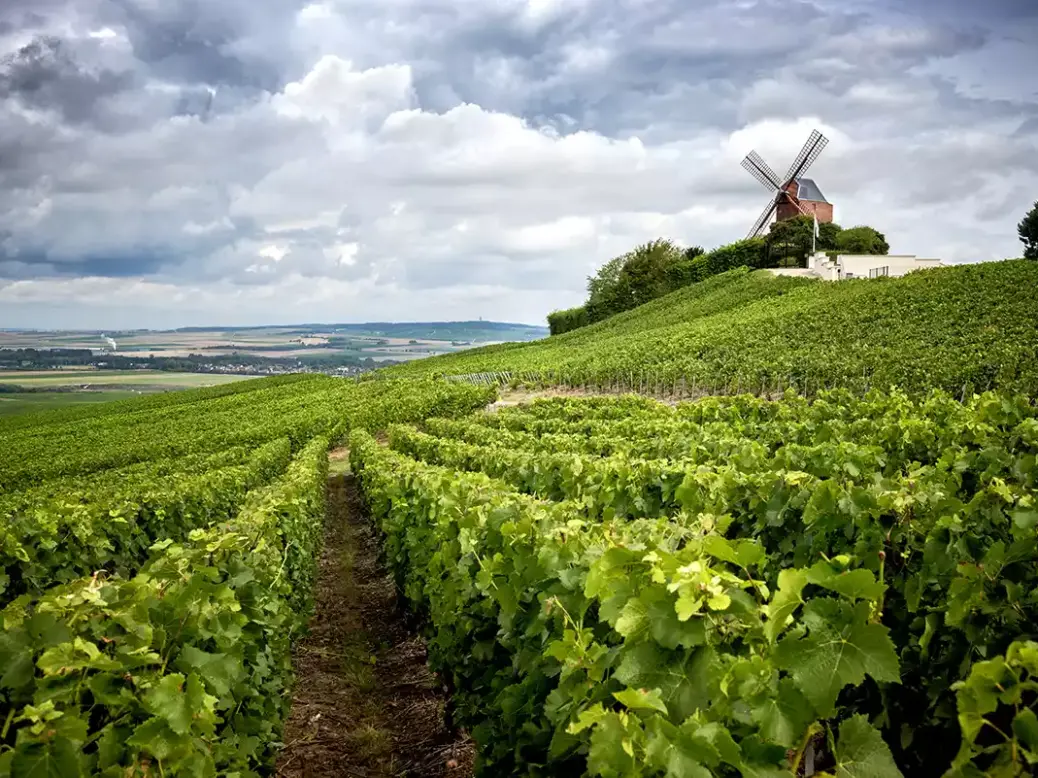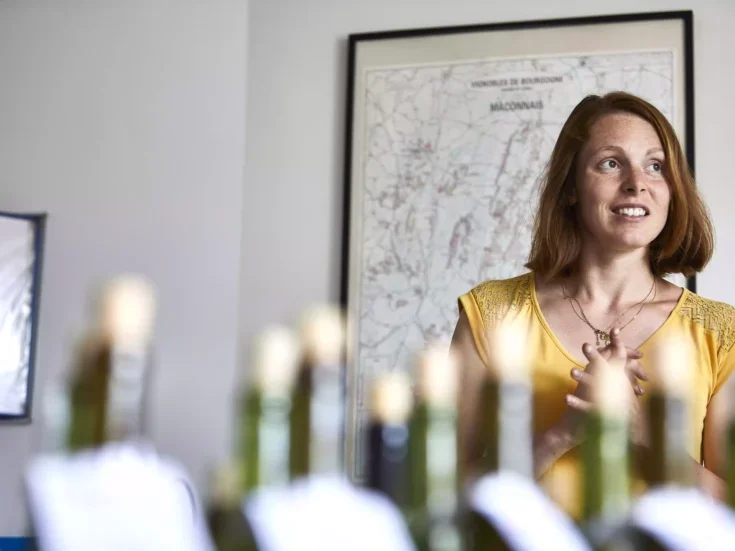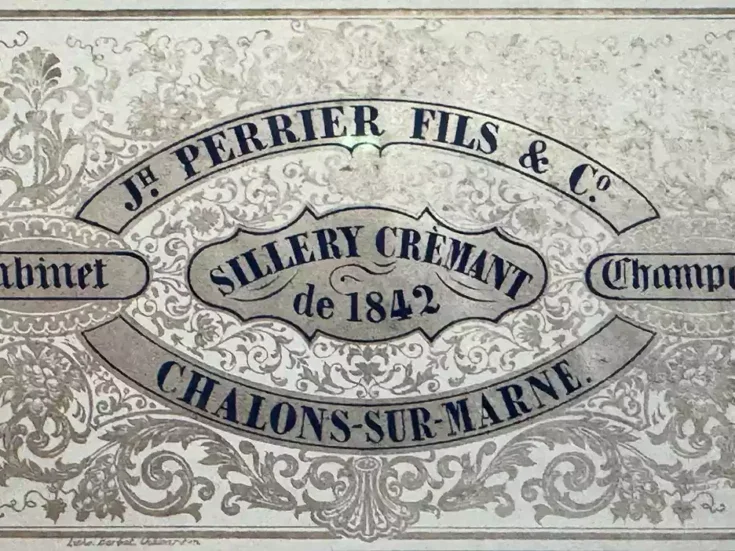
How do the wines of a vintage produced in “classic” conditions compare to those from a year more in keeping with the new, warmer normal in Champagne? Essi Avellan MW is joined by Simon Field MW and Tom Hewson for a tasting that suggested the differences are more stylistic than qualitative.
For scores and detailed notes on all 46 wines included in the tasting, subscribe to The World of Fine Wine.
Champagne’s climate has changed over the past decades, from cool to temperate. Late-season, high-acid vintages are getting rare. Instead, we are witnessing more variability in weather conditions, shortening growth cycles, more sunshine, and drought. The cooler years of today might well be similar to the warmer years of the past, reaching proper ripeness seldom being a problem anymore. The consecutive vintages 2014 and 2015 are, in many ways, polar opposites. The 2014 displays a more classically cool wine profile, whereas the 2015 showcases the new climate’s effects for both good and ill. Both vintages are now widely available on the markets, so we wanted to put them to the test.
The 2014 Champagne vintage
The year’s vigorously alternating weather patterns kept the growers on their toes right up until the harvest. A particularly wet winter gave way to an unusually warm and dry spring, with very little rain between March and June. In July, murky weather with rains and storms arrived, and it was not until September that things started to look positive again. Autumn sunshine and warmth were once again able to rescue the harvest. Sugar levels rose rapidly, and a large crop (11,553kg/ha) was picked from September 8 onward. Despite the wet conditions, neither gray rot nor mildew ended up critically lowering the quality of the crop, though sorting was necessary. This year’s most talked-about culprit was the Drosophila suzukii fruit fly, blamed for the high occurrence of sour rot, especially for Meunier grapes. With an average potential alcohol of 10% and total acidity of 8.3g/l, it ended up being a fine harvest, whose wines are being appreciated for their vibrant acidity yet also an easiness of style. Less structured and intense than the best, this year’s wines charm with their aromatic purity and lush fruitiness.
The 2015 Champagne vintage
If the initially belittled 2014 is gaining in appreciation as the top wines reach the markets and the Champagnes mature, it is the opposite story for 2015, which was initially received with great excitement. After a wet winter and a mild spring, high temperatures and dry weather prevailed from mid-May until mid-August. Over that summer period, rainfall accumulated to a mere 39 percent of normal, thus the vines suffered from drought even on the chalky terroirs. The latter part of August brought pouring rain, but eventually sunny weather for the first two weeks of harvest let the vines avoid the biggest disease problems. The 2015 vintage was instantly found to have a lot in common with the equally sunny 2003 vintage, yet yields were much higher, at 10,602kg/ha. Consequently, the wines that came with an average potential alcohol level of 10.5% and total acidity of 6.9g/l turned out to be ample but fresh enough, avoiding excess heaviness.
What initially tasted like plush and promising base wines, however, started to disappoint as soon as the year’s Non-Vintage wines reached the markets. Unusual vegetal, ash-like aromatics causing austerity were found in many bottlings to some degree. Since there was ample sunshine and warmth, phenolic ripeness should not normally have posed any problems. But drought-related effects on ripening are believed to have caused these rustic aromatics. If the aroma had been detected early on, I doubt that so many Vintage wines and prestige cuvées would have seen the light of day. In fact, there is still some denial of the problem in Champagne (and not everyone seems sensitive to picking up the character in the wines either). Yet climate change is likely to give us more drought years in the future, which makes this issue of even greater importance for the growers and winemakers of Champagne.
The tasting
With fellow tasters Simon Field MW and Tom Hewson, we blind tasted a sample of 46 wines, from both houses and grower-producers. A clear majority, 27, were from 2015, with 19 from 2014. We had only eight pairs of exactly the same cuvée from both vintages, which makes drawing solid conclusions difficult. From these pairs, the 2014 ended up being our preferred vintage four times, while the 2015 won the duel three times. The winning 2014s were Taittinger Brut Millésime, Philipponnat Cuvée 1522, Philipponnat Blanc de Noirs, and Vilmart & Cie Coeur de Cuvée. We considered the 2015 superior for Drappier Millésime Exception, Pierre Gimonnet Special Club Grands Terroirs de Chardonnay, and Louis Roederer Vintage (though I had a strong preference for its 2014). Leclerc Briant Les Basses Prières received the same average score for both vintages.
By average score, 2014 won the tasting by the smallest margin—90.3 over 90.2. I had the strongest preference for 2014, which got an average of 0.41 points more from me. For Simon, the same figure was 0.16, whereas for Tom the vintages were practically on a par.
The top ten was dominated by 2015s, with six wines compared to four from 2014. The clear winners were Ruinart Millésime 2015 and Taittinger Brut Millésime 2014, both of which we all ranked consistently highly. The top ten did, however, include some wines that divided opinion—most notably, the Louis Roederer 2014, which I rated as high as 97, against Simon’s 91 and Tom’s 89. Overall, the tasters were quite nicely in sync when it came to the more reductive styles; however, for the more oxidative styles, our views diverged more often, with Simon having a preference for the style that neither Tom nor I shared.
Overall, the 2014s performed according to expectations, the wines being brightly fruity and fresh, with more classically lean structures and appealing lightness. I scored two 2014s very highly, but overall, they performed well while seldom excelling. Their current overtness and immediate appeal do make one wonder about the longevity of the wines, but at least, so far, all looks satisfying for them, with no obvious concerns.
Clearly capable of both highs and lows, the 2015 vintage occupied the top position in the tasting but also the eight lowest positions. The ash-like aromas were detected by all three tasters on certain wines. I find the aroma to detract from a wine’s purity—and the following austerity on the palate to compromise its finesse. Yet I was pleased to find many wines totally free from this character, and the hope must be that further post-disgorgement aging will build richness over the austerity on many more of them. For the rest, I didn’t let this aroma alone spoil a wine for me (despite being a sucker for purity), because there were clearly good elements in the wines, too, especially on the palate.
I was hoping to conclude something about the prominence of the vegetal aromatics based on grape variety, but in the tasting these seemed to be equally present in blanc de blancs and blanc de noirs. Overall, I am surprised by how ignored the distinctive vegetal character of many 2015s has been in discussions of Champagne. It is something that should be rapidly and thoroughly researched in the face of climate change, to avoid picking such grapes or including such base wines in blends in future.
There was no clear winner in the tasting, the wines being like chalk and cheese, with our personal preferences playing a big role in the appreciation. The lack of very high scores for either vintage also tells a tale.
The Top 5: The best of 2014 and 2015 Champagne
Ruinart Millésime Brut Champagne France 2015 (12.5% ABV) | 94
EA | Pale lemon color. Beautifully toast-complexed nose, with smoky-reductive and florally fragrant tones overlying the pristine orchard fruit core. The palate matches the nose with the fine, cushiony quality of the mousse and pristine, cool, and crunchy fruitiness. Good freshness and succulent fruitiness add on the wine’s deliciousness. A very good effort for the vintage. | 95
SF | Green-gold, with a generous, semi-savory aromatic; umami, quince, and even a hint of white truffle. Broader than many on the palate, but not at the expense of a rigorous and pleasing structure, deferential to the warm vintage in terms of ripeness, but constrained by the rigor of its own construction. Distinctive and not without distinction. | 95
TH | A beautifully exotic, almost dramatic nose of gunflint, mango, clementine, and blossom, this is a surprisingly svelte and brightly toned 2015 of notable refinement, subtly backed up by delicate lees-aging textural interest. The heat of the year is muted, teased into precise tropical fruits and finessed, smoky, charry notes, carefully balanced; impressive. 2023–28. | 93
Taittinger Brut Millésime Champagne France 2014
(12.5% ABV) | 94
EA | Deep lemon color. Gorgeously charred nose, with toasty, spicy, and sweetly fruity layers. Tropical fruit meets vanilla and exotic spices. Pristine fruitiness and sweet charm promise a lot for the palate. Very intense on the rich palate, which gets cut by a fine, racy acid line. Immediately impressive, with plenty of toasty wow factor and a juicy, flowing, long finish. Drinking perfectly but comes with further potential. 2023–28. | 96
SF | Straw-citric color, small bubbles; a nose of gunflint and quince, therefore reductive of inclination. Billows beautifully on the palate and not solely as a result of a generous dosage; quality of fruit, encyclopedic in intent, is the star here, and the result is more than agreeable. Approachable now and for several years henceforward, such is the quality of the composition. | 95
TH | Svelte, reductive style here, fragrant with bergamot and tropical nuances, almost toward passion fruit. Airy, bright, and elegant on the palate, Chardonnay leading here with delicacy and precision. Charming. | 92
Paul Bara Special Club Grand Cru Brut Champagne France 2015 (12.5% ABV) | 93
EA | Pale lemon color. Mild, florally scented nose, with cool and crisp white-fruit profile. Lemon juice, white flowers, and pear drops, with just a little toasty complexity. Rather youthful still, with little autolytic complexity. Lightweight palate, which comes across as a little stripped. Juicy, fresh, and energetic palate, finishing on a dry note. Very correct, with some cool elegance to it. 2023–33. | 93
SF | Pale color, limpid; a powerful and persistent mousse. Flinty, fruit-stone nose, kernels and pith, too. Lean, it seems, but less so on the palate, where the sugar sits a little awkwardly, unsure of how it will regiment the inherent quality. A transitional phase; this one needs more post-disgorgement time to settle down. Firm of purpose, at least, and that purpose appears well thought out! | 93
TH | This plays on the maturity rather than the angularity of the year, with a controlled, reductive character, white-peach succulence, delicate red fruit, subtle dairy characters, and plenty of detail—there’s a real sense of assemblage and equilibrium here. The mousse is well integrated, and the palate is shaped with rare elegance and clarity, Chardonnay’s fine, lightly puckering zestiness closing with sapidity rather than force. This even shows some chalky, mineral detail, which is not always present in this warm vintage. A fine 2015. | 93
Taittinger Brut Millésime Champagne France 2015 (12.5% ABV) | 93
EA | Bright, medium-deep lemon color. A very appealing and inviting nose of pristine fruitiness. There are plentiful sweet peach and apricot tones to it, with a twist of vanilla, pencil shavings, and fruit drops. Cool and crunchy fruit, with hardly any austerity. The palate comes across fresh and fluffy, with an expansive but elegant mousse. The sweet and juicy appeal lasts all the way through to the fresh and perky finish of pristine fruit. 2023–35. | 94
SF | Pale straw. Nose of red and green apple, plum, and quince; hedgerow and hints of petrichor. Yeasty notes take over on the palate, with hints of digestive biscuit and mirabelle plum; more expansive and accommodating, its dosage hitherto conspicuous but in no way overwhelming. Attractive, forward, and well primed for a pleasant evolution. | 92
TH | Refined aromatics of tart pastry, raspberry, and orange citrus, subtly reductive and backed up with nicely pitched crusty bread and toasted almond. This shows a measured white-peach ripeness, but little of 2015’s less desirable greenness. 2015’s bustling energy is made rather approachable on the palate here, succulent, with some pear juice, bitter lemon, and a careful, complete shape. 2023–33. | 93
Louis Roederer Vintage Brut Champagne France 2015 (12.5% ABV) | 93
EA | Pale lemon color. Soft, fruity nose, with creamy-leesy tones and some toast and hay adding on the secondary aromatics. A melange of ripe orchard fruit, with apple and peach at the fore. A faint vegetal tone is well-hidden under the pristine fruitiness. The palate matches the nose, with appealing, sweet fruitiness and its creamy textural qualities in the refined, cushiony mousse. Long, juicy length of softness and pristine fruit. An appealing whole, with good freshness and energy. Pleasurable already but worth cellaring further. 2023–38. | 95
SF | Attractive straw-gold, iridescent, with a garland of pinprick mousse. The nose is reticent, dignified maybe, with soft fruit and a hint of wet pavement and spice. More expressive on the palate, vanillin kissing the apples, plums, and soft mango in support. Dosage is evidenced, but not intrusively. Approachable now, sensual rather than cerebral, but pleasingly orchestrated. | 93
TH | Pleasing brown-bread and blackberry nose, showing ripe and aromatic Pinot Noir, backed up by some zesty and punchy Chardonnay. This avoids 2015’s aromatic peculiarities, presenting a mature and food-friendly style of mid-palate Pinot breadth and closing citric grippiness. Direct. | 90






